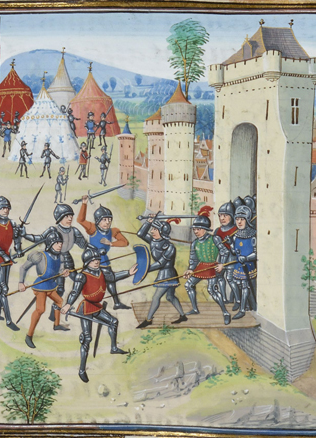Food: Eating Grass
In the 13th and 14th century, both pagans and Christians would often be equalled by starvation as the lack of food was a common thing. Low economic productivity and shortage of alternative crops to compensate poor harvests would prove dire calamities to people’s lives not to mention adverse weather conditions, plant and animal diseases and epidemics, and wars. Lack of everything, food in the first place, and repeated famines has formed the model of social welfare. Those who could afford or access to enough food and attire would store everything safely in warehouses, barns or sheds. The abundance of food, which usually emphasises prosperity, might and wealth, accompanied by the obligatory etiquette, has been meticulously described in many sources while speaking of feasts, both pagan and Christian, which a generous and hospitable host was expected to arrange.
The Daily Bread
Grain and meat were the two staple foods in the 13–14th century Lithuania. Cereal and pulses dominated the menus leaving about 30 percent of the total diet for meat and 10 percent for milk products. Out in the fields, rye was the main cereal. People in Lithuania also grew wheat, oats, barley, millet, beets, peas, beans, lentils, vetch, buckwheat, hemp, poppies and caraway. Most of them were used to bake bread and to prepare porridges. Findings from certain mounds feature bits of bread (in Maišiagala) and fragments of a peel (in Kernavė and Vilnius), all from the 14th century. The excavated grinding and rotating quern-stones assert the fact of bread baking. Bread was a valuable dish on every table. Even the great dukes’ guests would be treated with bread. In 1377, the abundant table the Grand Duke Algirdas offered to the Order’s Marshall and his guests featured mead and bread. By mentioning the plenty of bread, the chronicler apparently wished to highlight the abundance of various meals. Bread was also used as money by merchants to pay trade fees while crossing private lands, according to the 15th century sources. A scone made of coarsely ground grain, often full of chaff, presumably was a more usual treat than bread, then a luxury.
Novelties from Livonia
People would supplement their daily ration of cereal products with vegetables, particularly turnips, that stay good throughout winter and can be consumed raw, boiled or fried. Some anthropologists maintain that abundant consumption of turnips was to blame for the ever-greater spread of teeth plaque in the 14th century. Others argue that teeth decay became more common due to starvation and diseases. Turnip seeds, hoes and meagre residues of spades found by archaeologists provide some information on the culture of gardening in Lithuania but there are no written documents that evidently specify garden-grown plants except caraway, mustard and poppies mentioned in the 14th century documents and mostly used as spices.
The culture of gardening spread slowly, and the list of cultivated vegetables was fairly short. At the turn of the 14th century Lithuanians would keenly buy radish or other varieties of turnips, onions and cabbages from Livonia, the vegetables in considerable demand but rarely grown in Lithuania. Cabbages were introduced by the brothers of the German Order. People in Prussia had their own idea about cabbage eating that turned into an anecdotal story written down by Peter of Dusburg in his chronicle: “Since [he] saw the brothers eating cabbages that Prussians do not consume, he took it for grass and added: “(…) They eat grass like horses and mules, so who will be able to fight them back if they can easily find food even on barren lands?”
Cabbage growing spread in Prussia and Livonia. In Livonia, cabbage gardens belonging to peasants and town-dwellers have been mentioned in documents from the early 14th century. Alongside, onions and radish or turnips were easy to cultivate. In addition to that, beets, garlic, peas, beans and apparently mustard was grown in the 14th-century Livonian gardens. People in Lithuania must have had started growing these vegetables, so popular with their neighbours, too. In the 14th century, they cultivated several imported novelties of the time, such as sweet peas, brought from Southern Europe, as well as buckwheat and lentils. Fruits added somewhat to a modest selection of foods. Quality apples were a rarity in the early 14th century because they were imported from Livonia as well. Imported foods must have also included pears, cherries and plums, the seeds of which were found in the main castles of the Gediminid dynasty, such as Kernavė and Vilnius. First orchards in Lithuania must have been planted in the second half of the 14th century. Forest products, such as berries, nuts and mushrooms, must have added to the poor menu of the needy.
Honey was apparently the sole sweetener of hard and short lives of the people.
The delicacies the magnates relished in
Meat was an important product. A number of the 13th and 14th century sources of the Lithuanian historiography refer to cattle breeding and fodder making, particularly from hay and oats. During military raids, cattle and fodder were important objects of plunder and obliteration. Better breeds of cattle were in great demand because the noblemen strived to enlarge their herds, then a measure of wealth, and to ensure meat is on their tables for all feasts and parties. The osteological material from the 13th and 14th century gathered during archaeological examination of old settlements allows to calculate that the period’s husbandry was dominated by herds of large cattle (45 percent), pigs (25–37 percent) as well as sheep and goats (11–17 percent). However, beef consumption was relatively modest. Many cattle were raised just for milk and field work and only pigs were grown for meat. Additional meat supplies would come from hunting on aurochs, wisents, moose, deer, roes, wild boars, and occasionally bears. However, the game meat wasn’t particularly popular. On the average, bones of the domestic animals account for as much as 90 to 100 percent of the total in the excavated areas.
Milk was considered more a food than a drink. Cows of the time produced very few milk, just 100 to 200 litres a year. However, people would milk sheep, goats and mares, which suggests that large quantities of different milk could have been collected. The chemical analysis of a pot found in Kernavė reveals that the vessel was used for storing cream or sour cream. Jan Długosz’s chronicle bears a confirmation of the fact that Samogitians, in line with the pagan rite, would render their respect to the deceased with offerings of mead and a cheese-like product. In general, milk was a product of luxury: the Grand Master of the German Order treated the Grand Duke Vytautas with cheese.
Poultry was dominated by hens, geese and ducks.
Their eggs and meat would end up on dinner tables while feathers were used to stuff magnates’ beds.
On the other hand, fish and cray-fish were for people from all walks of life, one just needed to make an effort to catch it in numerous lakes and rivers. The analysis of fishbones and scales points to a great variety of fish the top choice being pike, followed by perch, chub, bleak, dace, roach, rudd, cod, bream, silvery bream, sheatfish, and zander. Occasionally, residues of sturgeon have been excavated, the fish that would traditionally spawn in Nemunas and its tributaries. Even though herring was abundant in the Baltic Sea until the 14th century, eventually abandoning the waters for sprat, salted herring was usually brought in Lithuania from Riga. Herring and other sea fish, such as cod and salmon, would end up on the tables of dukes and noblemen.
Food preparation and thermal processing wasn’t exactly sophisticated neither was it adequate. The analysis of teeth reveals that foods usually were hard to chew and would leave all eaters above 30 with considerably ground-off teeth surfaces.
Literature: Lietuvos istorija, t. 3, XIII a. – 1385 m.: Valstybės iškilimas tarp Rytų ir Vakarų. D. Baronas, A. Dubonis, R. Petrauskas. Vilnius, 2011.
Artūras Dubonis



